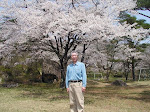Bashō's Dream
335 years ago, in 1689, 松尾芭蕉 (Matsuo Bashō) (1644-1694) visited 象潟 (Kisakata) in 秋田県 (Akita Prefecture) as part of his journey on『おくのほそ道』(The Narrow Road to the Deep North) and wrote the following haiku.
象潟や雨に西施がねぶの花
kisakata ya ame ni seishi ga nebu no
hana
Donald Keene (鬼怒鳴門) translated this haiku into English.
Kisakata―
Seishi
sleeping in the rain,
Wet
mimosa blossoms.
In
2004, Hidenori Hiruta visited Kisakata and composed haiku:
Bashō’s
wind
circling
stone tablet
midsummer
清風や蕉風立ちぬ夏の句碑
seifū ya shōfū tachinu natsu no kuhi
This
haiku appeared in the Asahi newspaper’s Asahi Haikuist Network by David
McMurray in 2004, who noted that “Hidenori Hiruta in Akita wrote his haiku in
celebration of the 360th anniversary of Matsuo Bashō’s birth.”
In
2021, Hidenori wrote another haiku, inspired by a statue of Bashō and a stone monument bearing his haiku, and
a statue of 西施(Xi Shi)standing nearby in Kisakata.
象潟や語り部の如ねぶの花
kisakata ya kataribe no goto nebu no hana
Kisakataー
like a storyteller
mimosa blossoms
Note: Bashō’s
Dream
In the
grounds of 蚶満寺 (Kanman-ji)
Temple in Kisakata, there are statues of Xi Shi, a beautiful woman from the Yue
country during China's Spring and Autumn period in the 5th century BC, and
Matsuo Bashō, a Japanese haiku
master active in the 17th century.
According to the travelogue "Oku no Hosomichi" (The Narrow Road to the Deep North), which describes a journey in 1689, Kisakata was the northernmost destination. At that time, Kisakata was a scenic spot that rivaled Matsushima, and Bashō described its beautiful archipelago as "Matsushima seems to be smiling, but Kisakata wears a look of grief." It is said that Bashō based his haiku on Su Dongpo's (1036-1101) poem "West Lake." In the poem, the beauty of West Lake is likened to the beauty of Xi Shi.
Bashō arrived at Kisakata at around 3pm, when the sun was beginning to sink in the sky. Just then, a misty rain started to fall, creating a hazy landscape. 鳥海山 (Mount Chōkai) was obscured, but ねぶの花 (the mimosa blossoms) stood out in front. Kisakata was exquisite in the rain. He wrote in his haiku that the landscape of Kisakata was just like Xi Shi sleeping in the rain.
Now, in the 21st century, the landscape has changed dramatically since the Kisakata earthquake of 1804, but ねぶの花 (the mimosa blossoms) remain as beautiful as ever. A statue of Bashō and a stone monument bearing his haiku have been erected in Kisakata, and a statue of Xi Shi stands nearby. Bashō's haiku spirit survives beyond time and space. Perhaps it was Bashō's dream for haiku to exist in this way for ever.
February
2, 2025
蛭田 秀法
HIRUTA Hidenori
.jpg)
.jpg)


0 件のコメント:
コメントを投稿